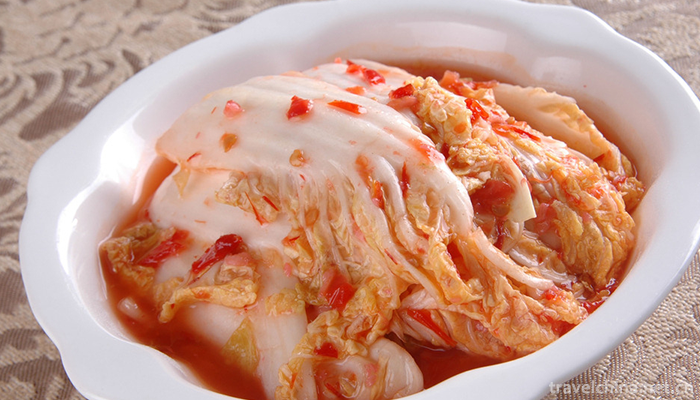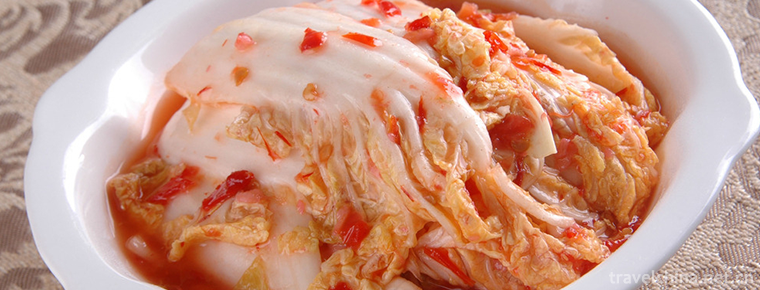Kimchi Making Skills Korean Kimchi Making Skills
Kimchi Making Skills Korean Kimchi Making Skills
Kimchi of Korean nationality is one of the traditional food with the most national characteristics of Korean nationality, and its pickling method is constantly enriched and developed. In the long history, the Korean people in China have absorbed the advantages of other nationalities'diet and made up for their weaknesses. They not only preserved the culinary habits of kimchi from their ancestors, but also created the Korean kimchi culture with Chinese characteristics.
Pickles have a long history of pickling. According to the Book of Songs, pickles made from cucumbers about 3,000 years ago are called "tobacco", which is what modern people call pickles. Ancient pickles were only salted with brine or vinegar. The collection of poems and essays "Dongguo Xiangguo" also recorded the situation of pickled radish pickles. According to the October article of the New Year Records of the Eastern Country written in the mid-19th century, pickling in summer and pickling in winter became the "big plan of a year" for every household. This custom has continued to this day in the Korean countryside of our country. Nowadays, kimchi is not only a necessary storage food for Korean people all year round, but also a favorite side dish.
There are many kinds of pickles. The names and tastes of pickles vary according to the main ingredients and accessories. There are mainly pickled cabbage, vulgar cabbage, pickled mustard, pickled radish, pickled garlic, pickled onion. Pickles with Chinese cabbage as the main ingredient include hot cabbage, hot pepper seed pickles, white pickles and so on, the most common of which is hot cabbage.
Spicy cabbage is a popular food. People can taste its delicious taste almost anytime and anywhere. But spicy cabbage tastes exquisite, but many people do not know. Spicy Chinese cabbage needs to chew slowly, which is not only beneficial to digestion, but more importantly, spicy Chinese cabbage contains a variety of vitamins and acidic substances. Only chewing slowly, these substances can be fully absorbed and utilized.
Hot cabbage, as a traditional Korean diet, is well known in Northeast China. Because of the popularity of Korean Current, China on the Tongue Tip and Yanbian Taste, Korean pickles marked by spicy cabbage are also well known to the whole nation. When I was doing my master's thesis, I had conducted unstructured interviews with some local, foreign and foreign Han people about Korean cultural representation. One of the keywords that almost all respondents would mention was "hot cabbage".
At the end of the 19th century, a large number of Korean ancestors moved into the northeast of China, and their national culture and a wide variety of pickles were introduced. Although the living and living environment in foreign countries has changed dramatically, they still maintain their own cultural traditions and unchanged eating habits for a long time. From the early reclamation to the struggle with the Japanese Emperor, in these hard years, they were never interrupted and encouraged every day, except for one cavity of blood, which was the unchanged kimchi as a concrete manifestation of national culture, and also satisfied the consolation of their own soul. It is precisely the skills of the nation, which are convenient to preserve, cheap, crisp, refreshing, cold-resistant, warm-up traditional diet to accompany and support them through the most difficult times, and continue to "ferment" their deep desire for national liberation and their firm belief in sticking to and inheriting national culture.
As spicy cabbage slowly tastes in the transformation of time, I also gradually "ferment" under the influence of Korean culture. Some anthropologists often try to "turn themselves into local people", but they are still regarded as outsiders, and my anthropologist apprentice may have a little better luck and become a "half Korean" in his classmates'daily jokes. Of course, this not only refers to more than half of my taste buds conquered by Korean cuisine, but also to the fact that Korean culture has been subtly integrated into my personal world.


-
1.Ali Mountain
Mount Alishan, located 75 km east of Jiayi City, Taiwan Province, is located at an altitude of 2,216 meters. Its coordinates are 23 degrees north and 31 minutes east
Time 2018-10-30 -
2.Yunpu Dongtian Tourist Area
Yimeng Yunpu Cave Tianshan Scenic Area is located in Feixian County, Shandong Province. There are five scenic spots: Tour Stone, Tianmeng Lake, Drunken Stone Forest
Time 2018-12-22 -
3.Yanzidong in Jianshui County
Jianshui Swallow Cave is located in the Lujiang River Valley, more than 20 kilometers east of Jianshui County, Honghe Hani and Yi Autonomous Prefecture, Yunnan Province.
Time 2019-01-21 -
4.Gesar
Gesar (Sr) came into being in the second half of the 17th century and spread among the Mongolian people in Mongolia, Liaoning, Jilin, Heilongjiang, Qinghai, Gansu, Xinjiang and other provinces and reg
Time 2019-05-01 -
5.Boxwood carving
Boxwood carving is one of the traditional folk carving arts in Zhejiang Province. It uses boxwood as carving material and uses the natural form of boxwood, which is smooth, delicate in texture and sol
Time 2019-05-04 -
6.Venus Inkstone Making Skills
Venus inkstone making technology, the local traditional handmade inkstone making technology in Xingzi County, Jiangxi Province, is one of the national intangible cultural heritage.
Time 2019-05-07 -
7.Qin an Xiaoqu
Qin'an Xiaoqu, also known as the old tune of Qin'an, is one of the national intangible cultural heritages. It is an ancient traditional folk art variety formed and mainly popular in Qin'an and other c
Time 2019-06-10 -
8.Wulin Diao
Wulin Diao evolved from the folk propaganda of Baojuan and formed in the late Qing Dynasty. The performance form of Wulin tune is mainly sitting and singing, which combines narrative and singing. One
Time 2019-06-30 -
9.Southwest Jiaotong University
Southwest Jiaotong University is a national key university directly under the Ministry of Education. The first batch of national "double first-class", "211 project", "characte
Time 2019-08-31 -
10.The social background of Cheongsam
Many scholars and media at that time believed that it was an important reason that women imitated men to wear long gowns in order to seek independence of mind and emancipation of women's rights in the early Republic of China.
Time 2020-12-11 -
11.Neijiang science and technology
In 2019, Neijiang City completed 195 science and technology projects above the municipal level, and applied for 2509 patents and obtained 1425 authorized patents, including 456 invention patents and 90 authorized invention patents. At the end of the year, there
Time 2020-12-16 -
12.Meishan climate
Meishan city is located in the middle and low latitudes, located in the west of Sichuan Basin and the middle reaches of Minjiang River. It is characterized by the alternation of sea land monsoon every year. It has four distinct seasons, mild climate, abundant rainfall,
Time 2020-12-18